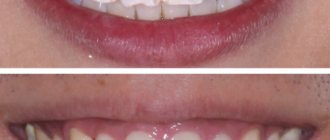Home / Articles / Restoration of chewing teeth
Every person wants to have beautiful, even, and, most importantly, intact teeth. But, unfortunately, time and lifestyle leave their mark on the condition of our teeth. In addition, as a rule, many people seek help from a doctor when they feel unwell. Consequently, the tooth is already at a significant stage of destruction and it is no longer possible to do without extensions. Dental restoration methods can help restore your teeth to their former shape or correct their imperfections.
Bridge prosthetics
The principle of installing a bridge is simple and known to many - adjacent teeth are ground down, a structure is made of three crowns - two “empty” and one solid in the middle. Empty crowns are used to cover ground teeth, and the structure is attached to dental cement. A full-bodied crown replaces a missing tooth in a row.
Advantages of the method: fast, inexpensive.
Disadvantages: traumatization of healthy teeth, since in most cases they need not only to be ground for a prosthesis, but also to be depulped. Injured teeth can soon cause new problems, and you will have to worry about restoring your dentition again.
What does aesthetic restoration correct?
Restorative procedures will eliminate a number of shortcomings:
- congenital defects in the structure of teeth,
- minor orthodontic deviations,
- traumatic defects,
- interdental gaps,
- changed enamel color,
- carious, non-carious enamel damage,
- pathological abrasion,
- destruction of old filling material,
- missing part of a tooth.
The result of the procedure is the achievement of aesthetics of the dentition, the return of functionality, as well as the psychological comfort of the patient.
Removable dentures
Removable orthopedic structures can be made from various materials - nylon, acrylic, plastic with a metal base, etc. They can be used in cases where there is nothing to attach the bridge to, that is, to solve the problem of an end defect.
Advantages of the method: affordable price, no trauma to hard tissues or mucous membranes, the ability to correct the end defect.
Disadvantages: lack of comfort, long habituation, hygiene requires daily removal of the prosthesis and its cleaning outside the oral cavity, relatively short service life.
Types of composite material for high-quality dental restoration
The German-American composite composition Estet X is the optimal solution. A complete aesthetic dental restorative system, highly polishable, with the physical properties of the most sought after hybrid dental composites. The material for artistic restoration is distinguished by its sculptural plasticity, holds its shape, and is comfortable for the dentist to work with. Absolute naturalness as a result of composite dental restoration.
Filtek (Filtek) is a photopolymer material, a nanocomposite, which is often called a gel filling. Optimal material for high-quality restoration of chewing and anterior teeth. High strength, availability of multi-layer dental restoration, low shrinkage, wear resistance, the material can be polished well, a wide range of shades for dental restoration.
Doctors at the 32 Dent clinic perform high-quality aesthetic restoration of teeth using Estet X, Filtek materials, etc.
Classic implantation
If one tooth or several scattered defects are missing, you can use classic dental implantation. Its essence lies in the fact that an implant is surgically installed in place of the extracted tooth and takes root without any load. After complete engraftment, which is after 2-4 months for the lower jaw, and after 3-5 months for the upper jaw, the patient is given permanent prosthetics. It is important to choose strong and durable materials for prosthetics. So, for example, ceramics are not suitable for the chewing zone - they are aesthetic and very naturalistic in appearance; they will not withstand chewing loads for a long time. In this case, metal ceramics or zirconium dioxide are well suited as prostheses. Zirconium can be used on absolutely everyone, and metal ceramics can only be used on patients who do not have allergic reactions to metals.
Advantages of the method: reliability, durability, no trauma to other teeth in the row, absolute comfort in using dentures on implants.
Disadvantages: the need for surgical intervention, high cost compared to conventional prosthetics.
Chewing teeth – all about an integrated approach to treatment and restoration
Chewing teeth are premolars and molars on the upper and lower jaws. They take on the main load during chewing. If pain and other suspicious symptoms appear in this area, it is important to quickly find a good clinic in Moscow and undergo timely treatment.
The teeth in the distal, or back, parts of the jaws do not greatly affect the appearance of the smile, but they perform a number of very important functions. It's best to keep them whole and healthy for as long as possible. However, due to their remote location, it is more difficult to clean them efficiently from plaque and food debris than the front incisors. Partially destroyed or completely missing molars deprive a person of the ability to chew food thoroughly and lead to displacement and destruction of other teeth.
On a note! Premolars usually have one root, and only in rare cases is it bifurcated. Molars can have from 2 to 5 roots. In the very last molars - sevens and eights - the root system is often highly branched and tangled, which significantly complicates their treatment and even removal.
Read about modern methods of restoring chewing teeth further in this article.
Single-stage implantation
Separately, it is worth mentioning about one-stage dental implantation in the chewing zone. If at a dentist's appointment you hear a disappointing verdict that a tooth needs to be removed, do not rush to the surgeon's office. Find out from your dentist if there are any indications for immediate implantation in your case.
This is a protocol that is minimally invasive. The problematic tooth is removed and an implant is immediately inserted into the fresh socket. There is no need to cut the mucosa and apply stitches. In addition, one-stage implantation saves time, since the patient does not need to wait for the wound to heal after removal so that classical implantation can be done.
Advantages of the method: minimal trauma among all implantation protocols, reliability, longevity of the result.
Disadvantages: not suitable for all patients. If the bone tissue under the diseased teeth is destroyed or thinned out, it will not be possible to place an implant at once.
Results of the procedure
The final result directly depends on the skills of the dentist who performed the restoration. Not only professional skills play an important role, but also artistic and sculptural abilities. The natural properties of tooth enamel should also be taken into account: firstly, the shade and transparency of the coating changes from the cutting edge to the gum. If these nuances are not taken into account, the restored tooth will stand out from the rest.
Advanced composite materials currently used in dental clinics have properties that mimic the natural characteristics of tooth enamel, in particular transparency. The professionalism of the doctor in combination with high-quality materials allows you to achieve excellent results, achieving optimal aesthetics of the dentition and the return of previous functionality.
To extend the life of the restorative composition, it is highly advisable to grind and polish the material during your annual mandatory visit to your dentist. Since the composite material shrinks and is stained by external colorants, such as in food, periodic treatment will keep the restorative structure in perfect condition. Changes in color and shape are not so significant, but prevention should not be ignored.
How is dental implantation performed?
The implantation procedure provides for separate prosthetics if 1-2 dental units are lost, and a dental bridge for more extensive jaw defects. The classic method, known for 50 years, is two-stage implantation.
With its help, you can gradually implant an implant, wait until it takes root, and perform prosthetics. The treatment period reaches 3-6 months.
Implantologists at Family Dentistry have several treatment protocols at their disposal, allowing you to choose the most suitable one in each specific case.
Why is it important to promptly restore chewing teeth?
In place of lost teeth, bone tissue gradually decreases, and implantation cannot be done using all methods. Unfortunately, this is not the only problem:
- the functioning of the stomach and intestines is disrupted, dyspepsia and flatulence appear;
- the contours of the face change, the cheeks fall in, wrinkles appear;
- diction and bite changes, the growth of the remaining teeth is disrupted.
Such consequences are unacceptable and significantly worsen a person’s quality of life. Therefore, it is imperative to get rid of the defect in the dentition. This can be done with the help of a dental bridge, removable denture and, preferably, implantation.
Average price for composite dental restoration in Moscow
The final cost of composite dental restoration depends on:
- types of composite material;
- number of dental surfaces treated;
- recovery difficulty level;
- selected clinic;
- qualifications of the doctor performing artistic restoration of teeth;
- the number of teeth that need to be restored;
- the need to pre-clean or treat teeth and gums.
The average price for artistic composite dental restoration in Moscow is from 4,500 to 13,000 rubles per unit. This price includes:
- photodiagnosis of teeth;
- anesthesia;
- rubber dam application;
- direct tooth restoration with high-quality heliocomposite material with precise selection of the optimal crown color;
- checking occlusion after dental restoration;
- recommendations for oral care after restoration.
Consultation with a dentist who specializes in composite restoration is free!
For complete dental restoration, just one visit to the dentist’s office is enough.
The main stages of dental restoration using composite materials
Stage No. 1 - Determining the boundaries for the future filling: in this place, carious lesions, remnants of the previous filling material or inlay are removed, the bottom of the tooth cavity is prepared, and the edges are processed.
Stage No. 2 – Isolation of dentin if the filling cavity affects the dentin boundaries. To prevent possible burns of the pulp by the composite filling material, a special gasket is installed. Open dentinal canals are moistened with special conditioners.
Stage No. 3 – Bonding is applied to the area of future restoration so that the future composite filling reliably “grabs” the natural hard tissues of the tooth. A filling material is placed into the treated cavity, the composition is polymerized with UV rays to harden, after which the doctor grinds and polishes the tooth.
Stage No. 4 – The shape of the tooth is adjusted depending on the bite. The surface of the teeth is covered with a protective glaze.
Main types of dental restoration
1. Aesthetic (artistic) restoration – work with photopolymer filling material that imitates tooth tissue in color, transparency and texture. The doctor uses reflective gel composites and bonding so that the filling “sticks” with natural tissues during the artistic restoration process. This method of artistic restoration allows us to remove the following points:
- diastemas between dental units;
- unsightly tooth color;
- color stains on teeth.
2. Restoration to restore a tooth after mechanical damage - cracks, chipping of up to 1/3 of the crown, if the tooth has broken into two or more parts. The doctor restores the structural integrity of the dentin layer and enamel to create a new, whole and no different tooth.
3. Artistic composite restoration of the smile area is a piece of jewelry when it is necessary to bring the front group of teeth to perfection. When there are objective indications for such restoration, the dentist works with gel composites that restore the opaque, dentin layers and tooth enamel.
4. Restoration of chewing teeth - relevant when no more than a quarter of a molar or premolar tooth is chipped. Doctors use innovative composites with the addition of ceramics for strength, while visually they fully match the color and transparency of natural tooth enamel.
5. Composite restoration to straighten crooked teeth. A more affordable and relatively quick alternative to orthodontic treatment. The convenient method of composite restoration allows you to correct minor changes using filling material.










